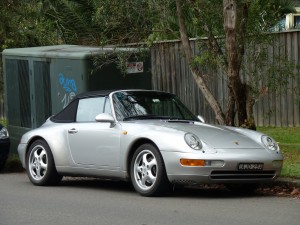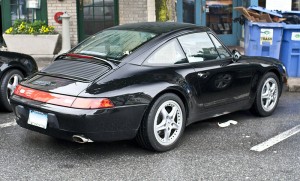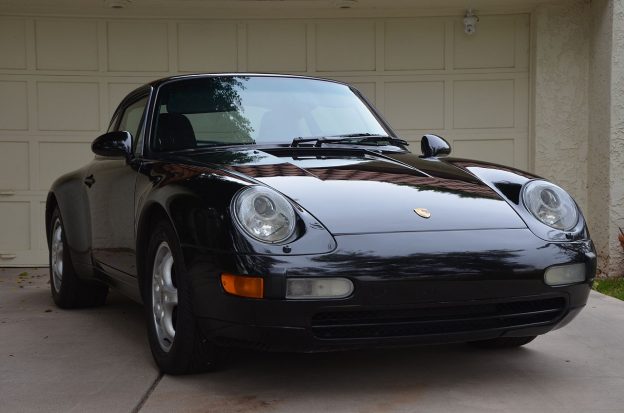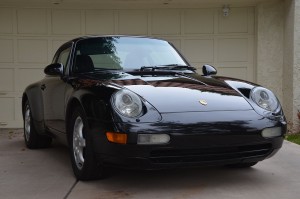It will be 20 years this August that Apple introduced its first iMac, which began a dramatic reversal of fortunes for the then-struggling computer maker. Around the same time, the last air-cooled Porsche 911 models were leaving the building.
Two decades ago, Porsche ushered in a brave new age with the mid-engine Boxster and a new-generation 911. Their six-cylinder boxer engines were liquid cooled, a necessity to meet tightening emissions and fuel economy standards while simultaneously boosting performance. It was a win-win on paper, but many Porsche purists will tell you that the 1995-1998 911 is a more exciting car to drive than its successor.
(993 Porsche Coupe photo courtesy Nkp911m500)
Known by its internal model code, 993, that final air-cooled 911 combines the visceral personality of its forbears with modern power, handling, safety and luxury. It was offered in a wide gamut of variants, foreshadowing the staggering number of model choices in the current 911 lineup. Coupe and convertible styles were available in rear-wheel or all-wheel drive, the latter also used on the mighty 400-horsepower Turbo.
(993 Porsche Turbo photo courtesy Frank and Myra Fan)
Porsche built about 26,400 993 models for the U.S., with 2,400 of those built as Turbos. Prices started at $60,000 for the rear-wheel drive Carrera (1995).
Triumphant Revival
Years before, some in Porsche management had marked the 911 for extinction, to be replaced by front-engine, liquid-cooled models. Yet, it was those cars, the 924/944/968 and 928, that, as good as they were, nearly drove Porsche into a ditch. By 1993, Porsche’s sales in the U.S. had dropped to 3,700 cars.
The 911, at least, had survived and grown better and stronger. The 964 series (1989-1994) brought higher performance, greater comfort and available all-wheel drive for the first time in a production 911. The AWD helped tame the 911’s propensity for snap-throttle oversteer, and it also made driving one in slippery weather easier.
The 993 was a surprisingly comprehensive makeover for a car that would remain in production for just three years. Its all-new aerodynamic body was clearly influenced by Porsche’s 959 supercar. But this was no mere restyle of the 964. It was a new stiffer and lighter body with much new chassis tech beneath. A multi-link rear suspension on a new aluminum subframe replaced the trailing arms that had been used since the 911’s inception 30 years before. The new configuration went a long way toward preventing the oversteer that had been, for many situations, a sometimes frightening part of the 911’s character.

(993 Porsche Cabriolet photo courtesy OSX)
The Cabriolet returned looking sexier than ever, but the Targa was a bit of a misstep. Instead of the classic Targa’s lift-off roof, there was an elegantly designed but complex retracting glass roof. It was not popular; just over 1,000 were made for the U.S.

(993 Porsche Targa photo courtesy Mr. choppers)
Near-Supercar Performance for the Time
Porsche said the 993’s six-cylinder boxer engine was 80 percent new. Its 272 horsepower was a respectable 10-percent jump over the prior engine, and was later bumped up to 285 horsepower with a variable intake system.
The air-cooled snarl was in full form. (“Air-cooled” is not the whole story; 911 engines also relied on a generous oil supply to handle some of the cooling duties, which is why the 993’s engine takes 11 quarts of oil.) The 993 was the first 911 with a 6-speed manual transmission; the Tiptronic automatic was a 4-speed.
The Carrera 4 introduced a new, simpler and lighter all-wheel drive system than the 964-series Carrera 4 used, now featuring a viscous coupling center differential. The system also became standard for the 400-horsepower Turbo. Even the base 993-series 911 Carrera was very fast, with 0-60 in about 5 seconds and a top speed of nearly 170 mph.
It was the 993’s supremely well-rounded character, however, that won it unanimous acclaim. Writing in Car & Driver, Peter Robinson said, “No 911 has ever handled as well nor been as easy to drive. But do not think for a moment that this more friendly temperament has compromised driving pleasure.”
Well said.
Why you’d want a Porsche 993-series 911:
The last air-cooled 911 was a true landmark Porsche.
More visceral driving character than its liquid-cooled 996 successor.
Lots of choices: coupe, convertible, rear-wheel drive, all-wheel drive and Turbo.
Still in the realm of affordability among classic 911s.


